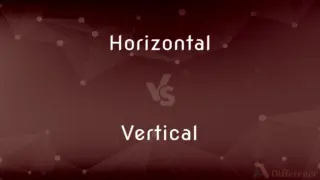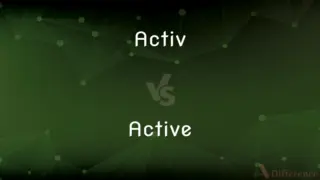Sidereal Day vs. Solar Day — What's the Difference?
By Tayyaba Rehman — Published on October 23, 2023
A Sidereal Day is the time it takes Earth to complete one rotation relative to distant stars, roughly 23.93 hours. A Solar Day measures Earth's rotation relative to the Sun, about 24 hours.

Difference Between Sidereal Day and Solar Day
Table of Contents
ADVERTISEMENT
Key Differences
Duration: A Sidereal Day is slightly shorter than a Solar Day. It's approximately 23.93 hours long, whereas a Solar Day lasts close to 24 hours. This difference results from Earth's orbit around the Sun.
Tayyaba Rehman
Oct 23, 2023
Accumulated Discrepancy: Over a year, the small difference between a Sidereal and Solar Day accumulates. This results in approximately 366.24 Sidereal Days but only 365.24 Solar Days in a year.
Tayyaba Rehman
Oct 23, 2023
Application: Astronomers often use Sidereal Days when observing celestial bodies to account for Earth's rotation. In contrast, our daily activities, schedules, and clocks are based on the Solar Day, which is why it has more practical significance for most people.
Tayyaba Rehman
Oct 23, 2023
Reference Point: For a Sidereal Day, the Earth's rotation is measured concerning distant stars, while for a Solar Day, it's measured concerning the Sun. Consequently, the Sidereal Day provides a view of Earth's true rotation, while the Solar Day aligns with our daily experiences.
Tayyaba Rehman
Oct 23, 2023
Cause of Difference: Earth moves a bit in its orbit around the Sun each day. Due to this movement, when measuring Earth's rotation using the Sun as a reference (Solar Day), it takes slightly longer than when using distant stars as a reference (Sidereal Day).
Tayyaba Rehman
Oct 23, 2023
ADVERTISEMENT
Comparison Chart
Cause of Difference
Earth's orbit around the Sun
Earth's rotation relative to the Sun
Tayyaba Rehman
Oct 23, 2023
Yearly Accumulation
Approx. 366.24 days in a year
Approx. 365.24 days in a year
Tayyaba Rehman
Oct 23, 2023
ADVERTISEMENT
Definitions
Sidereal Day
Used for precise astronomical observations.
Observatories might prefer the Sidereal Day for their measurements.
Tayyaba Rehman
Oct 06, 2023
Solar Day
Occurs about 365.24 times in a year.
Our yearly age increments after 365.24 Solar Days.
Tayyaba Rehman
Oct 06, 2023
Sidereal Day
Occurs roughly 366.24 times in a year.
In a year, we experience more Sidereal Days than Solar Days.
Tayyaba Rehman
Oct 06, 2023
Solar Day
Time for Earth's rotation relative to the Sun.
Our daily routines are structured around the Solar Day.
Tayyaba Rehman
Oct 06, 2023
Sidereal Day
Time for Earth's rotation relative to distant stars.
Astronomers often base their calculations on the Sidereal Day.
Tayyaba Rehman
Oct 06, 2023
Solar Day
Roughly 24 hours in duration.
We've designed our clocks to match the Solar Day's length.
Tayyaba Rehman
Oct 06, 2023
Sidereal Day
A true representation of Earth's rotation.
The Sidereal Day offers insight into Earth's rotation without solar interference.
Tayyaba Rehman
Oct 06, 2023
Solar Day
Represents one day on Earth for most practical purposes.
Calendars and planners are based on the Solar Day cycle.
Tayyaba Rehman
Oct 06, 2023
Sidereal Day
Approximately 23.93 hours long.
The Sidereal Day is a bit shorter than what our clocks indicate.
Tayyaba Rehman
Oct 06, 2023
Solar Day
Basis for human activities and schedules.
Business hours align with the light and dark periods of the Solar Day.
Tayyaba Rehman
Oct 06, 2023
FAQs
Do our clocks follow Sidereal or Solar Days?
Our clocks are set to Solar Days.
Tayyaba Rehman
Oct 23, 2023
What causes the discrepancy between Sidereal and Solar Days?
Earth's movement in its orbit around the Sun.
Tayyaba Rehman
Oct 23, 2023
Do time zones affect Sidereal or Solar Days?
Time zones are based on Solar Days, not Sidereal Days.
Tayyaba Rehman
Oct 23, 2023
Which day is longer: Sidereal or Solar?
The Solar Day is slightly longer than the Sidereal Day.
Tayyaba Rehman
Oct 23, 2023
Why is a Sidereal Day shorter?
Because it's measured by Earth's rotation relative to distant stars, not the Sun.
Tayyaba Rehman
Oct 23, 2023
Does the Moon have a Sidereal and Solar Day?
Yes, but its rotation and revolution are synchronized, so they're nearly the same.
Tayyaba Rehman
Oct 23, 2023
Why do astronomers prefer the Sidereal Day?
It gives a more precise measure of Earth's true rotation.
Tayyaba Rehman
Oct 23, 2023
Can you notice the difference between these days in daily life?
Not easily, as the difference is just about 4 minutes.
Tayyaba Rehman
Oct 23, 2023
Are there exactly 365 Solar Days in a year?
No, there are about 365.24 Solar Days in a year.
Tayyaba Rehman
Oct 23, 2023
Is a Sidereal Day consistent throughout the year?
Yes, it remains consistent at roughly 23.93 hours.
Tayyaba Rehman
Oct 23, 2023
Which day accounts for leap years?
Solar Days, as leap years adjust for the discrepancy in Earth's orbit.
Tayyaba Rehman
Oct 23, 2023
Are both days affected by Earth's axial tilt?
Both days are a result of Earth's rotation, but the axial tilt mainly affects seasons.
Tayyaba Rehman
Oct 23, 2023
Author Spotlight

Written by
Tayyaba RehmanTayyaba Rehman is a distinguished writer, currently serving as a primary contributor to askdifference.com. As a researcher in semantics and etymology, Tayyaba's passion for the complexity of languages and their distinctions has found a perfect home on the platform. Tayyaba delves into the intricacies of language, distinguishing between commonly confused words and phrases, thereby providing clarity for readers worldwide.
















































